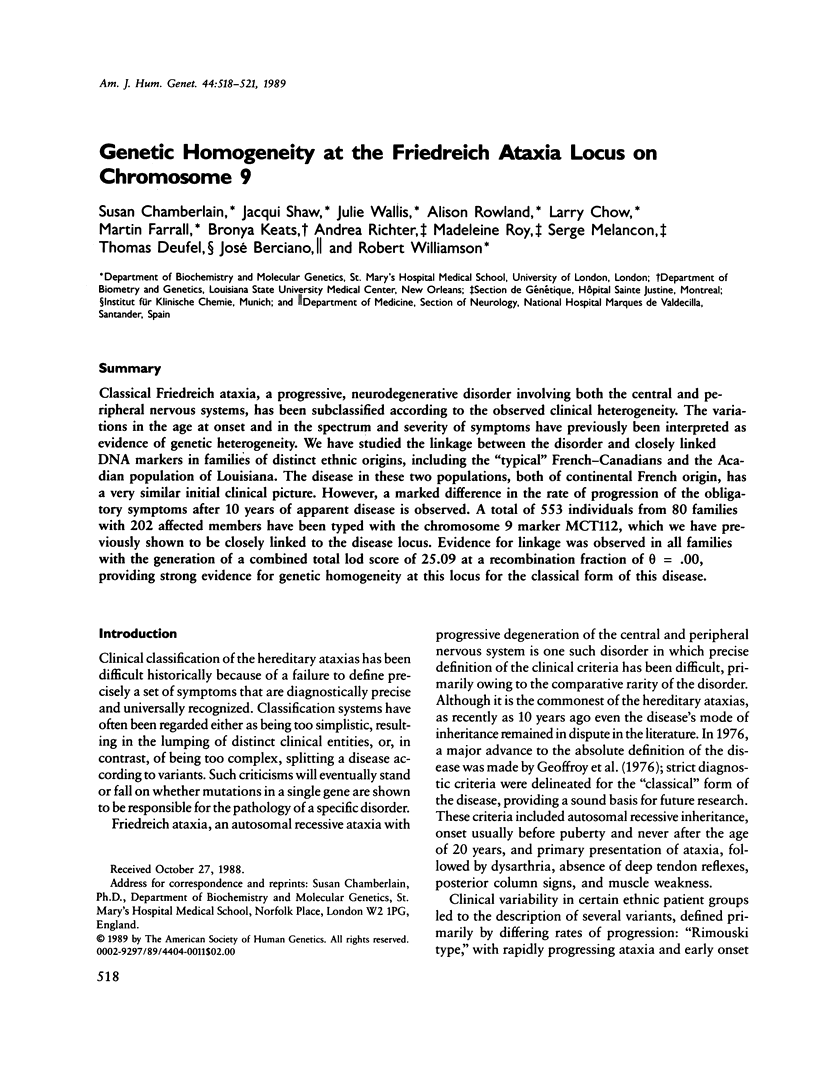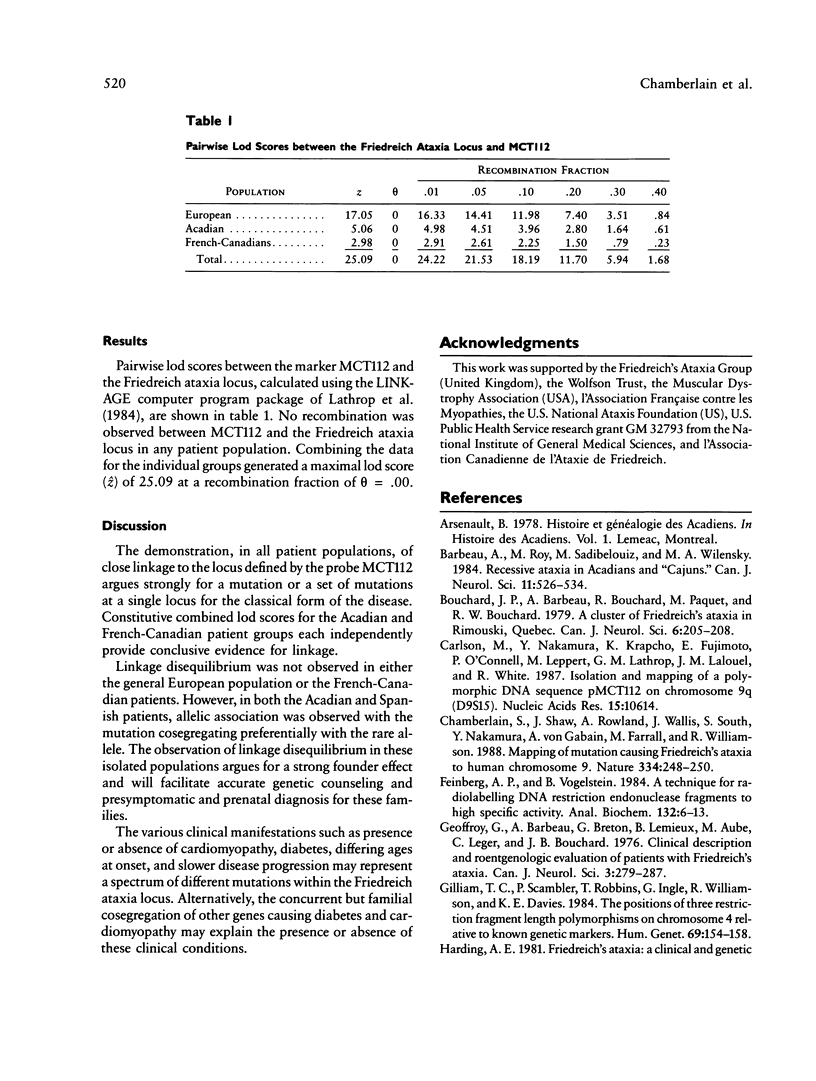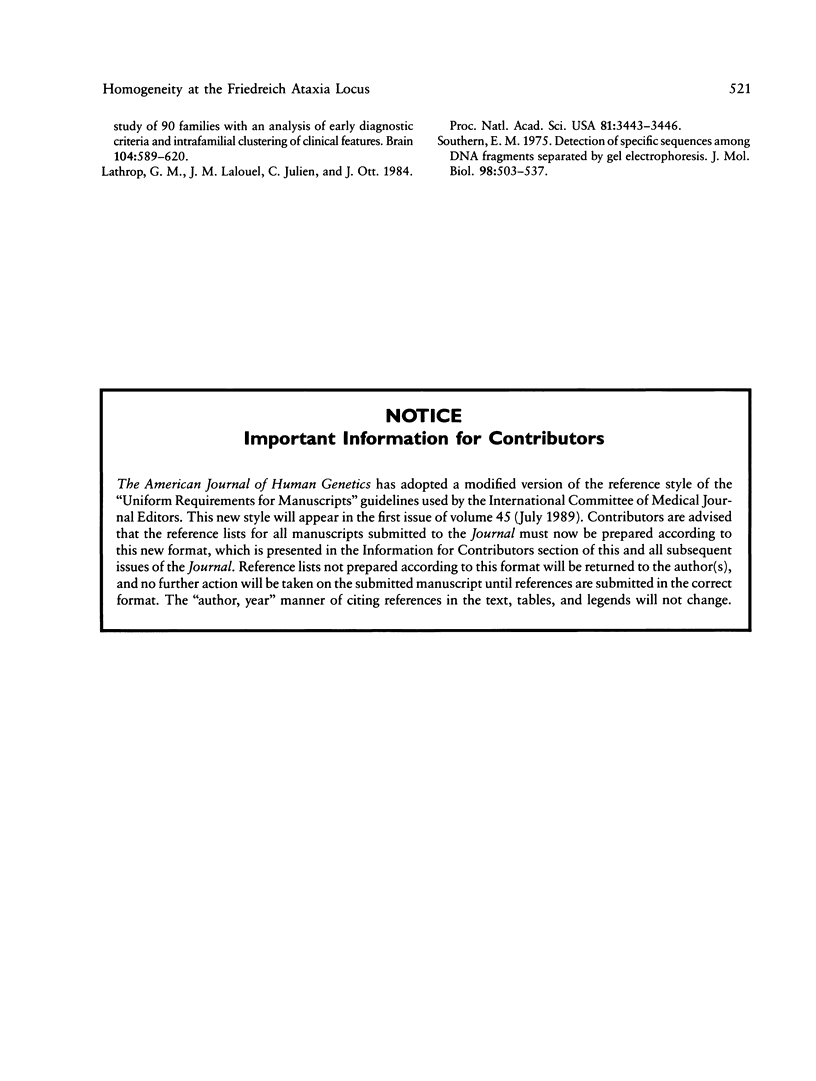Abstract
Classical Friedreich ataxia, a progressive, neurodegenerative disorder involving both the central and peripheral nervous systems, has been subclassified according to the observed clinical heterogeneity. The variations in the age at onset and in the spectrum and severity of symptoms have previously been interpreted as evidence of genetic heterogeneity. We have studied the linkage between the disorder and closely linked DNA markers in families of distinct ethnic origins, including the “typical” French–Canadians and the Acadian population of Louisiana. The disease in these two populations, both of continental French origin, has a very similar initial clinical picture. However, a marked difference in the rate of progression of the obligatory symptoms after 10 years of apparent disease is observed. A total of 553 individuals from 80 families with 202 affected members have been typed with the chromosome 9 marker MCT112, which we have previously shown to be closely linked to the disease locus. Evidence for linkage was observed in all families with the generation of a combined total lod score of 25.09 at a recombination fraction of θ = .00, providing strong evidence for genetic homogeneity at this locus for the classical form of this disease.
Full text
PDF



Selected References
These references are in PubMed. This may not be the complete list of references from this article.
- Barbeau A., Roy M., Sadibelouiz M., Wilensky M. A. Recessive ataxia in Acadians and "Cajuns". Can J Neurol Sci. 1984 Nov;11(4 Suppl):526–533. doi: 10.1017/s0317167100034995. [DOI] [PubMed] [Google Scholar]
- Bouchard J. P., Barbeau A., Bouchard R., Paquet M., Bouchard R. W. A cluster of Friedreich's ataxia in Rimouski, Québec. Can J Neurol Sci. 1979 May;6(2):205–208. doi: 10.1017/s0317167100119651. [DOI] [PubMed] [Google Scholar]
- Carlson M., Nakamura Y., Krapcho K., Fujimoto E., O'Connell P., Leppert M., Lathrop G. M., Lalouel J. M., White R. Isolation and mapping of a polymorphic DNA sequence pMCT112 on chromosome 9q (D9S15). Nucleic Acids Res. 1987 Dec 23;15(24):10614–10614. doi: 10.1093/nar/15.24.10614-a. [DOI] [PMC free article] [PubMed] [Google Scholar]
- Chamberlain S., Shaw J., Rowland A., Wallis J., South S., Nakamura Y., von Gabain A., Farrall M., Williamson R. Mapping of mutation causing Friedreich's ataxia to human chromosome 9. Nature. 1988 Jul 21;334(6179):248–250. doi: 10.1038/334248a0. [DOI] [PubMed] [Google Scholar]
- Feinberg A. P., Vogelstein B. A technique for radiolabeling DNA restriction endonuclease fragments to high specific activity. Anal Biochem. 1983 Jul 1;132(1):6–13. doi: 10.1016/0003-2697(83)90418-9. [DOI] [PubMed] [Google Scholar]
- Geoffroy G., Barbeau A., Breton G., Lemieux B., Aube M., Leger C., Bouchard J. P. Clinical description and roentgenologic evaluation of patients with Friedreich's ataxia. Can J Neurol Sci. 1976 Nov;3(4):279–286. doi: 10.1017/s0317167100025464. [DOI] [PubMed] [Google Scholar]
- Gilliam T. C., Scambler P., Robbins T., Ingle C., Williamson R., Davies K. E. The positions of three restriction fragment length polymorphisms on chromosome 4 relative to known genetic markers. Hum Genet. 1984;68(2):154–158. doi: 10.1007/BF00279306. [DOI] [PubMed] [Google Scholar]
- Harding A. E. Friedreich's ataxia: a clinical and genetic study of 90 families with an analysis of early diagnostic criteria and intrafamilial clustering of clinical features. Brain. 1981 Sep;104(3):589–620. doi: 10.1093/brain/104.3.589. [DOI] [PubMed] [Google Scholar]
- Lathrop G. M., Lalouel J. M., Julier C., Ott J. Strategies for multilocus linkage analysis in humans. Proc Natl Acad Sci U S A. 1984 Jun;81(11):3443–3446. doi: 10.1073/pnas.81.11.3443. [DOI] [PMC free article] [PubMed] [Google Scholar]
- Southern E. M. Detection of specific sequences among DNA fragments separated by gel electrophoresis. J Mol Biol. 1975 Nov 5;98(3):503–517. doi: 10.1016/s0022-2836(75)80083-0. [DOI] [PubMed] [Google Scholar]


